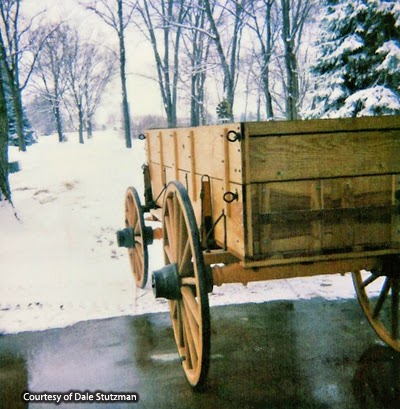In the tattered and fading files of
early wagon maker history, it’s not uncommon to find a builder
embellishing their vehicles with a logo in honor of their home state. The Vaughn Mfg. Company did that with
the name ‘Wisconsin’, as the Springfield Wagon Company did with the ‘Missouri’
name. Likewise, Winona touted the 'Minnesota' brand and Alexander Caldwell’s Leavenworth factory proudly promoted the ‘Kansas’
wagon. That said, it’s a bit more
unusual to find a builder selling wagons highlighting a state other than their own. That’s the case,
though, with the legendary Kentucky Wagon Company (KWC) from Louisville,
Kentucky as they placed the Tennessee name on thousands of wagons. So, how does an early wagon maker
headquartered in the Bluegrass State get to the point where they’re marketing
wagons promoting the Volunteer State?
 |
This cover is from an 1890’s-era promotional flyer for Tennessee brand wagons built by the Kentucky Wagon Company. |
We know that the Kentucky Wagon Company
built and sold countless wagons with the brand name of “Kentucky.” It’s a natural association that makes
sense. So, how does Kentucky’s neighboring
state fit in here? Known for its Old
Hickory and Kentucky brands, KWC also built wagons under the label of
Studebaker Model, American, and Tennessee.
My July 11, 2012 blog included a few details about the Kentucky Wagon Company but the legacy of
the firm runs a lot deeper. As I’ve
written before, the “Studebaker Model” brand was derived from the same patterns
and designs as those of the original Studebaker wagons built in South Bend,
Indiana. You can read more about this
arrangement in an article I wrote for Farm Collector magazine back in June of 2004.
 |
This catalog cover from 1893 references the still-fresh transition of Tennessee wagons from the firm of Cherry, Morrow & Co. to Kentucky. |
The truth of the matter is that KWC’s
“Tennessee” label is a brand that originated with another wagon maker. In fact, the name and logo actually predates
the formation of the Kentucky Wagon Company altogether. According to government trademark records,
the first use of the Tennessee name on a wagon was on January 1, 1878. At the time, the firm building these wagons
was known as Cherry, Morrow and Co., located in Nashville, Tennessee. The company started out under the name of
Cherry, O’Connor & Co. in 1871. By
1873, they were using prison labor from the State penitentiary as the primary
workforce. During the 1880’s, Tennessee
wagons were distributed throughout the southern U.S. as well as in Iowa,
Illinois, Indiana, Ohio, Nebraska, Kansas, and the Dakota’s. In addition to wagons, the company also built
stoves, furniture, and the Sarven patent wheel.
Vehicles in the original Tennessee-branded line included delivery
wagons, farm wagons, log wagons, emigrant wagons, spring wagons, carts, and
army wagons. By 1885, the company
boasted sales of more than 17,000 Tennessee wagons and, within two years, that
number had increased to over 20,000; a rate that equaled 75 vehicles
finished each day. In January of 1890,
the company’s lease with the state prison system expired and, with the growing
resistance to using incarcerated labor, a decision was made to sell the entire
firm to the Kentucky Wagon Company in Louisville.
By the time Kentucky purchased the
Cherry-Morrow factory, the Tennessee brand was an extremely popular and
well-established name. Hence, there was
great value and opportunity in keeping the Tennessee tag alive and well. It’s inclusion with Old Hickory and
Kentucky-labeled wheels only added to KWC’s growing market share, distribution,
and bottom line.
Like most early wood-wheeled creations,
the majority of the Tennessee vehicles have not survived. But, for those that have, their roots run
deep into the heart of America and the West.
During peak production times for the Kentucky Wagon Company, the firm
was responsible for building tens of thousands of wagons in a given year. From military escort wagons and sheep wagons
to chuck wagons, log wagons, farm wagons, drays, and more, KWC built transportation for a broad range of
uses.
Please
Note: As with each of our blog writings, all
imagery and text is copyrighted and may not be broadcast, published, rewritten,
or redistributed without prior permission of David E. Sneed, Wheels That Won
The West® Archives.














